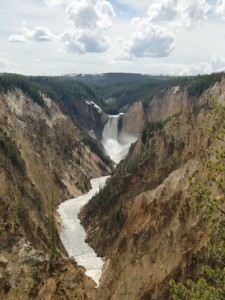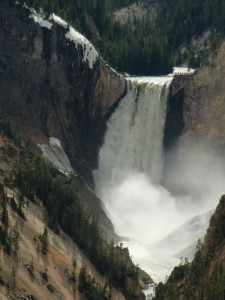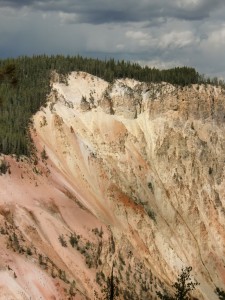THE BEST OF THE WEST – IN THE LAND OF THE GEYSERS (PART 2)
THE BEST OF THE WEST
This is the eighth in a series of articles about traveling the West by bus
IN THE LAND OF THE GEYSERS (PART 2)
By Charles N. Stevens
Photos by Dolores Seidman
By the time we reach Mammoth Hot Springs we are famished. Most of us edge into the crowded Mammoth Terrace Grill for lunch, waiting forever to be served. Finally fed, we retire to the lobby of the Mammoth Hot Springs Hotel where the air is cool and the lounge chairs inviting.
Having rested, we make our way back to the bus. Clouds that had been building all morning let loose with a sudden sprinkle, heavy enough that I duck into a restroom shelter to keep from getting wet. The shower stops as suddenly as it started, and I venture out again.
We look out on the steamy terraces or giant stair steps of Mammoth Hot Springs, a most unusual formation of dripping water, pools and white limestone stained here and there with rusty colored veins. From each terrace the wet limestone presents the illusion of flowing downward like a small waterfall, yet is static. It truly is one of nature’s most unusual sights. We wander along the paths provided, getting a closer look at the quiet pools, terraces and the incredible whiteness of the stone.
A pair of elk graze near the base of the hot springs, oblivious to the tourists and the passing cars. I marvel at their size and their formidable rack of antlers, having a healthy respect for their power.
As soon as we board the bus again a clatter of rain beats on its roof, the rattling sound of it much like being inside a snare drum. On our way again, we pass the old military barracks once used by army soldiers to protect the park before it became a national park and the park service was established. From our bus window we see a coyote nosing through the high meadow grass, a nervous bird diving at him again and again to ward him off. We pass more grazing buffalo and even a few elk. Another stray rain shower rakes our bus.
We roll by Roosevelt Lodge, named after Theodore Roosevelt, with its rustic cabins and horses available for trail rides. Then we come upon an amazing display of black columnar basalt on a hillside, the result of slowly cooling lava from that long ago eruption. The polygonal columns stand together as though they are part of the ruins of an ancient temple. Nearby, a black bear has caught the attention of a group of tourists bearing cameras.
We veer off the main road for a trip up towards Mt. Washburn, its snow-covered peak at ten thousand feet. As the bus negotiates the curves in the road, we look out on another graveyard of trees felled and burned by the great fire of 1988. Fortunately new growth rises from all that desolation. At last we are up above the timberline at 8700 feet where winter still lingers, icy snow banks lying on each the side of the road.
Down from the mountain, we arrive at the lower Yellowstone Falls where the Yellowstone River cascades down over 300 feet to the base of the canyon. The upper falls nearly a quarter mile back tumbles just over 100 feet. With many other tourists we walk to the lookouts, the low thunder of the falls filling the canyon. Not only is the canyon over 1,000 feet deep, but it is also colorful, its precipitous sides yellow, white and even pink. The dominant yellow color gave Yellowstone Park its name. Watching the magnificence of the falls wrapped in their all-encompassing sound, the sky dominated by fat cumulus clouds, is truly pleasurable. I note too that substantial trees have anchored themselves here and there along the vertical cliffs, making me wonder how they survive. We tarry here for over an hour gazing at the wonder of it all, breathing the fresh, pine-scented air.
Our trip back to Grant’s Village is delayed by a bad accident that closed the main road. People entranced by all there is to see, sometimes lose sight of other cars and run into them.
Back at the village in our hotel, a final rain shower with a single crack of thunder rounds out our busy day.

We look out at The Valley of the Yellowstone and the spectacular Yellowstone Falls.

The thunder of Yellowstone Falls fills the valley as clouds of spray are churned up by the falling water.

The sheer sides of the valley are predominately yellow, giving the park its name, but streaks of buff and even pink also tint the slopes.

The author and photographer enjoy their day at Yellowstone Falls.
MONTEREY PARK AUTHOR PUBLISHES 3RD BOOK ABOUT HIS EXPERIENCES IN WORLD WAR II- BACK FROM COMBAT
Charles “Norm” Stevens, a 40 year resident of Monterey Park and World War II Veteran has recently published the 3rd in his series about his experiences in WW II, Back from Combat: A WWII Bombardier Faces His Military Future. This book details the time from when he returned from combat in England where he flew 34 missions over Germany and France until the end of the war. Faced with large numbers of returning combat vets, and not knowing how long the war would continue, the military had to plan for their future. His options were whether to return to combat, become an instructor in the U.S., or receive new training that he would use in the Pacific. The book concludes with the end of the war with an Afterward that includes an update on the B-l7’s still flying in the U.S., as well as present day accounts pertaining to the war.
Stevens is the author of two previous books about his experiences:
An Innocent at Polebrook: A Memoir of an 8th Air Force Bombardier (Story of his 34 bombing missions from his base at Polebrook, England over Germany and France)
The Innocent Cadet: Becoming A World War II Bombardier (A prequel to the first, telling of his training in the U.S. before going overseas into combat.)
He is known to the readers of The Citizen’s Voice as the author of Travel Log Articles including “From Paris to Normandy on the Seine”, “Exploring New York” and “In Search of Snow.” He is retired, having taught for 32 years, primarily in the Montebello Unified School District.
Those interested in purchasing an autographed copy of any of his books, may contact the author at 323-721-8230 or Normstevens24@gmail.com.



